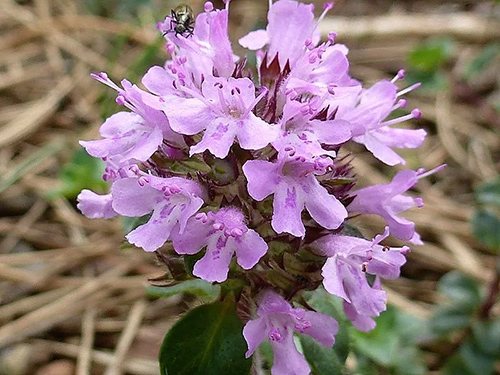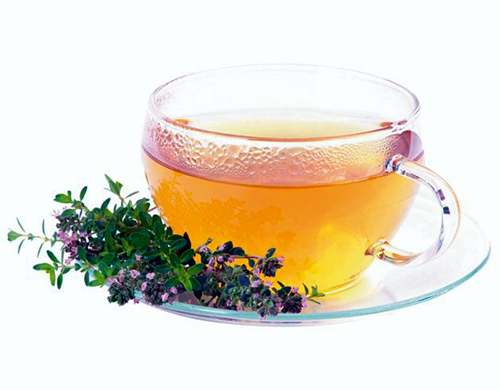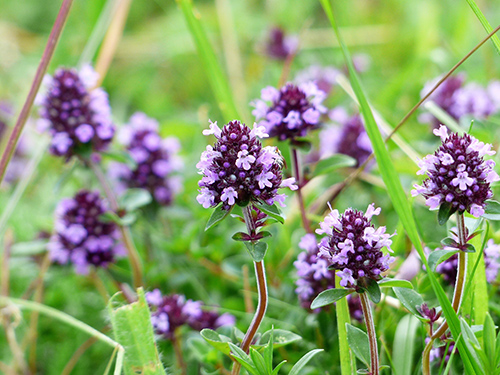Contents
The mother of thyme plant has a pleasant smell like other plants of the Labiatae family, such as wild marjoram, thyme, peppermint, or the European pennyroyal. It is difficult to tell the difference between this plant and thyme, mainly because there are some intermediate species. However, mother of thyme has three unique features:
- The upper lip of its calyx is divided into three deep teeth.
- The leaves are plain and green on both sides (thyme has whitish lower-sided leaves, with borders turned down).
- Its aroma resembles that of the lemon tree or balm.

Mother of Thyme Scientific Facts
- Other names: Wild thyme.
- French: Thym batard
- Spanish: Serpol.
- Environment: Dry, rocky soils in lowlands or mountain slopes up to 2500 m altitude all over Europe. It was naturalized in North America.
- Description: This vibrant plant of the Labiatae family grows up to 40 cm high and has ground stems, small, plain leaves, and pink or purple flowers in clusters.
- Parts of the plant used medicinally: The flower clusters.
Healing Properties and Indications

The leaves and flowers of the mother of thyme contain an essence which composition varies depending on the subspecies but is continuously formed by cymol, thymol, and carvacrol. It also contains small amounts of phenolic acids, flavonoids, and tannin. This essence gives the plant digestive, antispasmodic, expectorant, and antiseptic properties.
The applications of mother of thyme are similar to those of other plants of the Labiatae family, with several particularities:

- Respiratory disorders: Mother of thyme gives good results with coughs, especially convulsive coughing in children. It is also used for whooping cough and all kinds of bronchial catarrh.
- Digestive disorders: Mother of thyme is used to combat stomach atony, heavy digestion, flatulence, and dyspepsia in general.
- Oral and anal afflictions: Due to its antiseptic properties, this plant is highly recommended for washings and rinsings of wounds and inflammations of the mucous membrane of the digestive system, whether in the mouth (sores or aphtas) or the anus (anal fissure). In gargles, it renders good results for tonsilitis (sore throat) or pharyngitis.
- Rheumatism and neuralgia: in local applications, mother of thyme essence eases sciatica, facial neuralgia, and in general, all rheumatic pains.
- Depression, asthenia, and exhaustion: Hot baths with mother of thyme, which have refreshing and revitalizing properties, render good results. They are recommended both for weak children and for adults who need a natural stimulus.
Mother of thyme is a fantastic remedy for respiratory problems and helps clear mucus congestion from the respiratory passages and lungs. When used as a bath additive, the plant can stimulate blood flow toward the surface, thus alleviating nervous exhaustion. A mother of thyme infusion can relieve a headache caused by a hangover.
The plant is a tonic for the stomach and nerves and can treat mild gastritis, stomach cramps, and gastrointestinal problems such as enteritis. It is also suitable for painful menstruation, anemia, and insomnia. The herb can break the alcohol habit by inducing hunger, thirst, sweating, diarrhea, vomiting, and a disdain for alcohol. Repeat this several times (generally at longer and longer intervals) until the individual is weaned from the habit.
In external applications, mother of thyme is used for rheumatism, arthritis, stab wounds, tumors, and bruises.
NOTE: Sweeten with honey, except when used to treat gastrointestinal conditions.
How to use Mother of Thyme

- Infusion
- Essence: Take from three to five drops three times a day.
- Baths
- Bathing, mouth rinsings, and gargles
- Compresses and friction with the essence.
Infusion: Steep one to two teaspoons of the herb in one cup of water and take one to 1 ½ cups daily. Bath Additive: Add three to four ounces of flowers for a strong herb decoction to the bath water. Alcohol Cure: Add a handful of the herb to one quart of boiling water and steep in a covered pot for thirty minutes, give or take one tablespoon every fifteen minutes.
DISCLAIMER: All content on this website is presented solely for educational and informational objectives. Do not rely on the information provided as a replacement for advice, diagnosis, or treatment from a qualified medical expert. If you are pregnant, nursing, or have any preexisting medical concerns, talk to your doctor before using any herbal or natural medicines.
REFERENCES
- George D. Pamplona-Roger, M.D. “Encyclopedia of Medicinal Plants.” George D. Pamplona-Roger, M.D. Encyclopedia of Medicinal Plants. Ed. Francesc X. Gelabert. Vols. 1 San Fernando de Henares: Editorial Safeliz, 2000. 338, 339. Print.
- Vance Ferrell Harold M. Cherne, M.D. The Natural Remedies Encyclopedia [Book]. – Altamont, TN: Harvestime Books, 2010. – Vol. Seventh Edition: 7: pp. 183.
- https://www.webmd.com/diet/health-benefits-thyme
- https://pubmed.ncbi.nlm.nih.gov/24134630/
